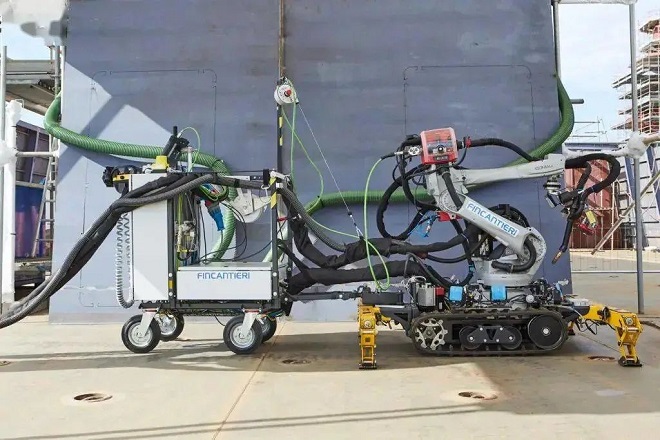造船业焊接用移动机器人“MR4Weld”成功亮相
MR4WELD Debuts: Mobile, Robotic Welding for Shipbuilding
发布者:KnowMi 发布时间: 2023-07-04 03:07:59 点击量: 2131 来源:Marinelink

著名工业机器人公司意大利柯马(Comau)与欧洲最大造船企业芬坎蒂尼集团开展合作,成功推出其首个研发成果:“MR4Weld”焊接用移动机器人,并在近日举办的2023慕尼黑国际机器人及自动化技术贸易博览会(Automatica 2023)上亮相。这一创新的室外用自动化解决方案被应用于船舶制造业,旨在提高船厂焊接作业人员的焊接质量、工作效率及幸福感。目前,两家企业正在对原型机器人进行测试,测试完毕后,“MR4Weld”将被投入到芬坎蒂尼旗下的船厂,开展自动化的钢结构焊接工作。相比起传统的手工焊接,这一方案可使生产效率提高3倍。“MR4Weld”焊接用移动机器人是一个高负载的6轴关节式机器人,其焊枪安装在履带式底盘上,集成的机器视觉系统能够自动识别焊接接头。更重要的是,它可以保证更好的焊接质量,从人体工程学角度改善工人作业环境。据悉,两家企业已就“MR4Weld”移动焊接机器人的具体技术特征联合申请了欧洲专利。
Italian companies Comau and Fincantieri presented today the first result of their joint collaboration with Automatica: MR4Weld (Mobile Robot for Weld), a mobile robot, an innovative outdoor automation solution, designed to improve the quality, performance and well-being of operators during labor-intensive welding activities. The MR4Weld mobile robot is being tested and will be used in the Fincantieri shipyards to autonomously weld steel structures, with the possibility of increasing operations up to to 3 times compared to a manual process, the companies project. Fincantieri and Comau have jointly filed a European patent application for some specific technical characteristics. The system features a high payload 6-axis articulated robot, equipped with a welding torch installed on a tracked undercarriage and with an integrated vision system to autonomously identify weld joints. It is designed to provide a better weld quality with improved ergonomics. Fincantieri and Comau have jointly filed a European patent application for some specific technical characteristics.
看新闻丨学英语
separate vt. 使分离;使分开
英/'sep(ə)rət/ 美/'sɛprət/
"Separate"一词源于拉丁语"separatus",它是由前缀"se-"(表示分离、分开)和动词"parare"(表示准备)组成的,原意为“准备离开”,现代英语中引申为“使分开,使分离”
Traffic Separation Scheme or TSS 分道通航制
分道通航制是由国际海事组织(IMO)制定的海上交通管理系统。分道航行制的具体条文及施行方法,位于国际海上避碰规则公约Part A第十条。分道通航制适用于通航密度较大的繁忙的航道。分道通航制,是指船舶“定线通航制”的一种,主要适用于一些通航密度较大的繁忙的航道,用分隔带、分隔线、天然障碍物或明显的地理物标等,将航道分隔成左右两个通航分道,实行单向通航。
bollard n. 系缆柱;带缆桩
英/ˈbɒlɑːd/ 美/ˈbɑːlərd/
"Bollard" 最早出现在16世纪的海事术语中。它来自于中古英语词汇"bole",意为“树干”或“原木”。最初,bollard指的是用于固定船只的木桩或木柱。
缆桩,又称“系缆桩”“带缆桩”。系指固定在甲板上或码头边用以系揽缆绳的粧柱。有单十字缆桩、双十字缆桩、直立式缆桩、斜立式缆桩和羊角形缆桩等。为使缆绳不易从缆桩上滑脱,一般在缆粧顶部覆有比桩身略大的桩帽。在船上,缆桩通常安装在船首、船尾和船中左右甲板上。